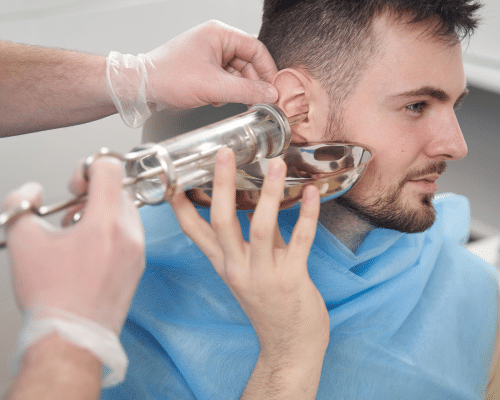Ear syringing is a method for removing earwax, but it may pose more risks and potential complications than the micro suction method.
What is Ear Syringing?
Ear syringing is the process of removing excess ear wax from the ear using water pressure and a tiny hose that is inserted inside of the ear.
Warm water is squirted into the ear to flush out the excess wax. As the water drains from the ear, the additional wax can also be washed away.
The procedure is typically performed by a qualified Nurse or Doctor.

Is Ear Syringing Safe?
Ear syringing can be helpful to remove excess ear wax. However it does come with risks and concerns. Inserting water into the ear canal is generally not advisable. There are some known complications which can occur during an ear syringing procedure, which patients need to be aware of before beginning this course of treatment. A 2003 study found that 1 in 1000 cases of ear syringing had major complications.
People who have low immunity, are diabetic, have a hole in the ear drum or those with current infections should avoid ear syringing and opt for a dry wax removal technique like microsuction that is performed at our Earworx clinics.
There are several potential problems with ear syringing and reasons why you should reconsider using this method to alleviate the symptoms of excess and impacted earwax.
It Can Fail to Remove the Wax
People who seek out an ear syringing procedure will be doing so to alleviate the symptoms of excess ear wax. These symptoms can include pain, itchiness, a blocked up feeling, dizziness and more. However, ear syringing has been found to often fail to remove all of the excess ear wax, resulting in the patient continuing to experience the same symptoms.
It is Ineffective for Impacted Wax
Ear syringing is only recommended for the removal of soft ear wax. Ear wax which has become hard and impacted is difficult to remove using water, and the amount of water pressure required can pose a risk of perforating the eardrum.
It Can Cause Ear Infections
If you are suffering or have suffered from an ear infection, ear syringing is not advisable as it introduces water to the ear canal which can exacerbate or cause infections. Ear syringing can sometimes leave water inside of the ear canal, which can get trapped behind impacted and deeply lodged wax. This can cause ear infections even in people who have not experienced them before.
It Cannot Be Used for People with Burst Eardrums
If you have a hole in the ear drum, you should not insert water into the ears and cannot have an ear syringing procedure. This can cause serious damage to the ear.
It Can Cause Inflammation
Occasionally, the water pressure and the presence of water inside the ear can result in some inflammation of the ear canal, which can cause discomfort for patients.
What Methods Should You Use Instead of Ear Syringing?
The best and safest way to remove excess and impacted ear wax is microsuction. Microsuction is a dry technique and safe method of ear wax removal. In addition to microsuction, you can soften and loosen your ear wax using softening drops from your local chemist if you do not have a hole in your ear drum.
More Information
If you have questions or concerns, feel free to contact the friendly Earworx team. We’re more than happy to help answer your questions and to assist you in relieving your ears of uncomfortable, wax-related symptoms.
